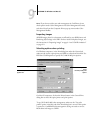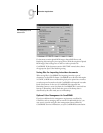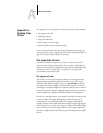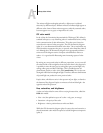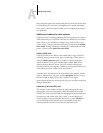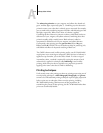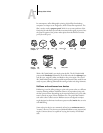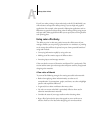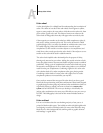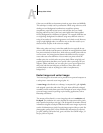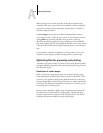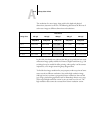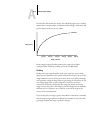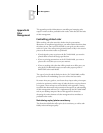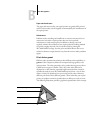
A
A-7 Desktop Color Primer
Color wheel
A color wheel (plate 8) is a helpful tool for understanding the interrelation of
colors. The colors on one side of the color wheel, from magenta to yellow,
appear to most people to be warm colors, while those on the other side, from
green to blue, appear to be cool. The distance between two colors on the
color wheel can help predict how they will appear when seen side by side.
Colors opposite one another on the wheel are called complements (plate 9),
and create a striking contrast side by side. This can be the basis for a bold
graphical design, but it is an effect you should use with discretion since it can
be visually fatiguing. Other bold combinations to consider are split
complements (a color and the two colors adjacent to its complement) and
triads (three colors evenly spaced on the color wheel). Colors adjacent to one
another on the color wheel result in subtle harmonies.
The color wheel simplifies color relationships for the purpose of clarity,
showing only saturated or pure colors. Adding the myriad variations of each
hue to the palette (more or less saturated, darker or lighter) creates a wealth of
possibilities. Taking a pair of complements from the color wheel and varying
the saturation and brightness of one or both colors produces a very different
result from the pure complements. Combining a light tint of a warm color
with a darker shade of its cooler complement often gives pleasing results.
Combining a darker shade of a warm color with a light tint of its cooler
complement produces an unusual effect you may like.
Once you have mastered the concept of the color wheel, you have a good
framework for experimenting with color combinations. Many books targeted
at graphic designers show groups of preselected color combinations. Some are
organized by themes or moods, and some are based on a custom color
system such as PANTONE. The more you develop a critical facility for
judging color combinations, the more you will be able to trust your own eye
for color. The bibliography at the back of this manual includes books on
design.
Color and text
It is not a coincidence that the overwhelming majority of text you see is
printed in black on white paper. Text in black on white is highly legible and is
not fatiguing to read for extended periods. For many color materials, using
black text on a white background and confining color to graphic elements
and headings is a good choice.



